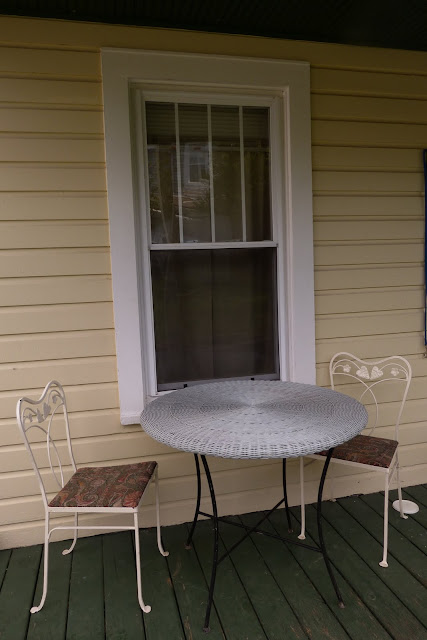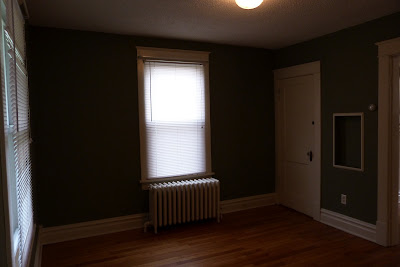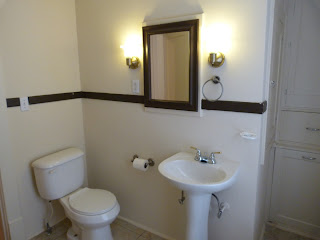Let me tell you a story about a desk. It had been left by the side of the street, unwanted, tossed aside, fated for destruction. But one day, a girl was driving by and spotted the forsaken desk. Having spent the last months entirely absorbed by Pinterest and DIY blogs, she saw in the desk a beauty just waiting to be revealed. All it needed was a little elbow grease and paint.
The girl asked her boy if he would help her get it home. The sad desk had been abandoned only a few blocks from their house. Unable to fit it in their car, the pair carried it home at nine o'clock that night. We can all be sure the neighbors had a good chuckle watching the new couple on the street lug the desk down the middle of the road.
I was that girl, and this is my desk. Before the transformation that is...

We went to work as soon as we could. To do something like this, one only needs sandpaper (admittedly, an orbital sander would make the project a million times easier), a few tools, primer, and paint.
There was an ugly and broken rubber trim around the top of the desk. I spent about fifteen minutes trying to get a tiny piece off and had nearly given up hope when Jordan came to my rescue. He spent at least an hour prying that stuff off using a hammer and a flat head screwdriver.

At this point, I had already sanded down the desk's bones. So, while he worked on the trim, I sanded down the drawers.
I read a lot of different opinions regarding sanding. Some people feel that to get the smoothest finish, you should sand down to the bare wood. Others say that it is only necessary to get the sheen off of the varnish. The primer that I bought said that no sanding was necessary. Because the desk was old and had been well used, the varnish was already peeling and made for a very bumpy surface. It was actually really easy for me to get down to the wood, so I did.
Well, except for the top, which is covered with some sort of laminate. I just scuffed it up as much as I could to make sure the primer and paint would stick.
The desk had a taken a bit of a beating and had a few bumps and scratches here and there. I grabbed a container of Elmer's wood filler and filled it in and smoothed it out. I applied this stuff around the trim as well to fill the space the rubber once occupied. The great thing about this product is that it is easy to use and can be sanded down once it dries. You don't have to get it just right when you apply it.

After another good sanding, two coats of primer, another sanding, two coats of paint, and a coat of Minwax Polycrylic Protective Finish, and another light sanding...we had a desk.
A note about primer and paint: I chose to use Olympic's Tailspin Linen for the "bones" of the desk and Allen + Roth's Rain Puddle for the drawers and top. Both are available at Lowes. I bought a quart of each for this project and still have plenty left. I followed the instructions of John and Sherry over at YoungHouseLove and used an oil based primer. You CAN use latex paint over an oil based primer, just not over oil based paint. It is important to apply two or three THIN coats of primer to ensure a more smooth final finish.
Without further ado...here is our beloved desk:
I wanted some fun hardware for the desk and just happened to find some over at Rule 42 on Byers Street. The owner, Dawn, does an amazing job salvaging and painting old furniture and has a friend who refinishes pieces. She also carries a lot of fun decorative items as well as paint, hardware, and other helpful DIY stuff. To keep the cost down, I decided to only get four and utilize the hardware that was on the desk when we found it.
A few last shots...The oval mirror and the banjo-back chair are other items we got at the yardsale. I plan to cover the chair seat with new fabric. Any suggestions for colors?
A quick cost breakdown:
Desk -- FREEBEE
Primer -- $10 (we have 3/4 of the quart left, so this will go a long way)
Paint -- $25 (again, we have a lot left. Also, a big thanks to my parents as they bought the paint for us!)
Minwax -- $10 (this stuff is pricey, but again, you only use a little bit at a a time. It will preserve the furniture much better than the paint alone so, while it is not absolutely necessary, I recommend it.
Hardware: $21 (Each knob was actually $6 a piece, but Dawn offers a 15% discount to MBC students!)
Total: $66 that will go a lot further when I use leftovers for other projects!
















































